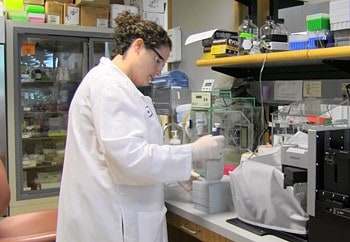An experimental vaccine against human cytomegalovirus (CMV) infection, which endangers the developing fetus, organ transplant recipients, patients with HIV and others who have a weakened immune system, proved safe and more effective than previous vaccines developed to prevent infection by the ubiquitous virus.
The first-of-its-kind approach to preventing human CMV infection, developed by a team of scientists at UC Davis and the University of Alabama, Birmingham, induced broader immunological protection in an animal model. The research study will appear in the November issue of the Journal of Virology.
Development of a CMV vaccine has been ranked as the highest priority by the Institute of Medicine, an independent agency of the National Academy of Science, because of “the lives it would save and the disabilities it would prevent,” according to the CDC.
“We’ve completed the first step in developing a vaccine to protect people against CMV by interfering with the virus’s attempts to enter and infect cells in the body,” said Peter A. Barry, a professor of pathology and laboratory medicine at the UC Davis School of Medicine and lead author of the study. Barry also is a member of the faculty at the Center for Comparative Medicine and a staff scientist at the California National Primate Research Center at UC Davis.
About CMV
CMV is a type of herpes virus that is spread through close contact with the saliva, urine or other body fluids of a person infected with the virus. Most CMV infections are not diagnosed because the virus typically causes few, if any, symptoms. As a result, most people infected with CMV are unaware that they harbor the virus – a condition that is of most concern among pregnant women, who are at risk for transmitting the virus to the fetus. Children who are congenitally infected with CMV may have cognitive and other developmental disabilities, including hearing loss and blindness.
CMV is the most common viral cause of congenital defects in the U.S. About 1 in 150 children in the U.S. is born with congenital CMV. While most of these children will not develop symptoms or problems, about 1 of every 5 children with congenital CMV infection – a total of 5,000 children each year – will develop hearing loss or developmental disabilities due to the infection, according to the U.S. Centers for Disease Control and Prevention (CDC).
CMV also can infect animals, including rodents and rhesus macaque monkeys and other non-human primates. However, the CMV species found in animals differs from human CMV and has not been reported to cause human disease.
A persistant virus
Because so many previous vaccine approaches failed to provide complete protection against CMV infection, Barry and his collaborators adopted an “out-of-the-box” approach when designing the new vaccine.
They focused on CMV’s ability to gain a lifelong foothold in the body, a stage of the virus’s life cycle that no other research lab has targeted in research on potential CMV vaccines.
“CMV is not like the influenza virus, which our immune systems can successfully clear from our bodies. CMV infection is persistent,” Barry said. “Once you’re infected, you’re always infected.”
The virus’s persistence and ability to infect individuals without creating obvious symptoms of infection help explain why CMV can be found in 50 to 80 percent of people under the age of 40.
Targeting a master immune system regulator
The key to CMV’s persistence, Barry and his colleagues theorized, is interleukin-10 (IL-10), the master regulator of the immune system, which works to rein in an over-zealous immune response to an invading pathogen.
Barry previously discovered that early in its evolutionary history CMV hijacked IL-10 and incorporated its genes into the virus’s own DNA code. As a result, CMV can manipulate the body’s normal immune response to the virus.
In developing their novel vaccine strategy, the researchers focused on neutralizing CMV’s own IL-10 so that the immune defense system was again capable of responding vigorously and effectively to the presence of the virus.
“We found that the animals did not become infected because, as a result of the vaccine, their immune systems generated neutralizing antibodies that prevented CMV from entering and infecting connective tissue cells, epithelial cells and other major cell types that the virus targets,” said Barry.
“The vaccine also created ‘immunological memory,’ which enables the immune system to respond quickly and effectively whenever CMV re-infection occurs,” he said.
Future studies
Based on these positive results, the researchers will evaluate the vaccine’s effectiveness and safety in an experimental setting that allows CMV-infected and vaccinated animals to interact, transmitting the virus as it typically would in the wild. By comparing rates of CMV infection in the vaccinated and non-vaccinated animals, the research team will determine whether the vaccine alters the natural course of CMV infection and should be considered for clinical studies with humans.
The research was supported by grants from the National Institutes of Health (R01 AI49342, RO1 AI047300 and 355 AI047300-S1), the Margaret Deterding Infectious Disease Research Support Fund and the California National Primate Research Center (P51356 OD011107).


